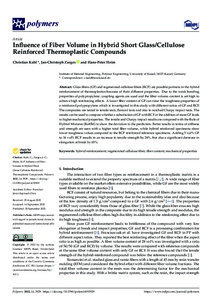Datum
2022-09-22Metadata
Zur Langanzeige
Aufsatz

Influence of Fiber Volume in Hybrid Short Glass/Cellulose Reinforced Thermoplastic Compounds
Zusammenfassung
Glass fibers (GF) and regenerated cellulose fibers (RCF) are possible partners in the hybrid reinforcement of thermoplastics because of their different properties. Due to the weak bonding properties of polypropylene, coupling agents are used and the fiber volume content is set high to achieve high reinforcing effects. A lower fiber content of GF can raise the toughness properties of a reinforced polypropylene which is investigated in this study with different ratios of GF and RCF.
The composites are tested in tensile tests, flexural tests and also in notched Charpy impact tests. The results can be used to compare whether a substitution of GF with RCF or the addition of more GF leads to higher mechanical properties. The tensile and Charpy impact results are compared with the Rule of Hybrid Mixtures (RoHM) to show the deviation to the prediction. Better results in terms of stiffness and strength are seen with a higher total fiber volume, while hybrid reinforced specimens show lower toughness values compared to the RCF reinforced reference specimens. Adding 5 vol% GF to 16 vol% RCF results in an increase in tensile strength by 26%, but also a significant decrease in elongation at break by 65%.
The composites are tested in tensile tests, flexural tests and also in notched Charpy impact tests. The results can be used to compare whether a substitution of GF with RCF or the addition of more GF leads to higher mechanical properties. The tensile and Charpy impact results are compared with the Rule of Hybrid Mixtures (RoHM) to show the deviation to the prediction. Better results in terms of stiffness and strength are seen with a higher total fiber volume, while hybrid reinforced specimens show lower toughness values compared to the RCF reinforced reference specimens. Adding 5 vol% GF to 16 vol% RCF results in an increase in tensile strength by 26%, but also a significant decrease in elongation at break by 65%.
Zitierform
In: Polymers Volume 14 / Issue 19 (2022-09-22) eissn:2073-4360Zusätzliche Informationen
Gefördert durch den Publikationsfonds der Universität KasselZitieren
@article{doi:10.17170/kobra-202210287050,
author={Kahl, Christian and Zarges, Jan-Christoph and Heim, Hans-Peter},
title={Influence of Fiber Volume in Hybrid Short Glass/Cellulose Reinforced Thermoplastic Compounds},
journal={Polymers},
year={2022}
}
0500 Oax
0501 Text $btxt$2rdacontent
0502 Computermedien $bc$2rdacarrier
1100 2022$n2022
1500 1/eng
2050 ##0##http://hdl.handle.net/123456789/14223
3000 Kahl, Christian
3010 Zarges, Jan-Christoph
3010 Heim, Hans-Peter
4000 Influence of Fiber Volume in Hybrid Short Glass/Cellulose Reinforced Thermoplastic Compounds / Kahl, Christian
4030
4060 Online-Ressource
4085 ##0##=u http://nbn-resolving.de/http://hdl.handle.net/123456789/14223=x R
4204 \$dAufsatz
4170
5550 {{Glasfaser}}
5550 {{Cellulosefaser}}
5550 {{Mechanische Eigenschaft}}
5550 {{Hybridtechnik}}
5550 {{Thermoplastizität}}
7136 ##0##http://hdl.handle.net/123456789/14223
<resource xsi:schemaLocation="http://datacite.org/schema/kernel-2.2 http://schema.datacite.org/meta/kernel-2.2/metadata.xsd"> 2022-10-28T10:02:36Z 2022-10-28T10:02:36Z 2022-09-22 doi:10.17170/kobra-202210287050 http://hdl.handle.net/123456789/14223 Gefördert durch den Publikationsfonds der Universität Kassel eng Namensnennung 4.0 International http://creativecommons.org/licenses/by/4.0/ hybrid reinforcementg regenerated cellulose fiber fiber content mechanical properties 600 Influence of Fiber Volume in Hybrid Short Glass/Cellulose Reinforced Thermoplastic Compounds Aufsatz Glass fibers (GF) and regenerated cellulose fibers (RCF) are possible partners in the hybrid reinforcement of thermoplastics because of their different properties. Due to the weak bonding properties of polypropylene, coupling agents are used and the fiber volume content is set high to achieve high reinforcing effects. A lower fiber content of GF can raise the toughness properties of a reinforced polypropylene which is investigated in this study with different ratios of GF and RCF. The composites are tested in tensile tests, flexural tests and also in notched Charpy impact tests. The results can be used to compare whether a substitution of GF with RCF or the addition of more GF leads to higher mechanical properties. The tensile and Charpy impact results are compared with the Rule of Hybrid Mixtures (RoHM) to show the deviation to the prediction. Better results in terms of stiffness and strength are seen with a higher total fiber volume, while hybrid reinforced specimens show lower toughness values compared to the RCF reinforced reference specimens. Adding 5 vol% GF to 16 vol% RCF results in an increase in tensile strength by 26%, but also a significant decrease in elongation at break by 65%. open access Kahl, Christian Zarges, Jan-Christoph Heim, Hans-Peter doi:10.3390/polym14193929 Glasfaser Cellulosefaser Mechanische Eigenschaft Hybridtechnik Thermoplastizität publishedVersion eissn:2073-4360 Issue 19 Polymers Volume 14 false 3929 </resource>
Die folgenden Lizenzbestimmungen sind mit dieser Ressource verbunden:


